The Kiga people, or Abakiga (“people of the mountains“), are an ethnic group located in northern Rwanda and southern Uganda. The Kiga speak a Bantu language called Rukiga. They are sometimes referred to as the Chiga or Kiga, while the singular form is Omukiga. It has been suggested that the Bakiga arrived in what is modern day Uganda from Rwanda between 1600 and 1700.
The Bakiga people live in southwestern Uganda and North Eastern Rwanda, mostly located in Kabale district (and Byumba prefecture in Rwanda.
History of the Bakiga
The Bakiga people are believed to have originated from Rwanda. It is even in one of their folk songs – Abakiga twena tukaruga Rwanda, omu Byumba na Ruhenjere, – meaning that all of us Bakiga, we came from Rwanda in Byumba and Ruhenjere (called Ruhengeri in Rwanda). Both Byumba and Ruhengeri are Rwandan cities. The Bakiga are believed to be the descendants of Kashyiga, who came to be called Kakiga son of Mbogo from the small Kingdom of Bumbogo in Rwanda later. He came to form the present community of the Bakiga of Kigyezi or Kigezi as a result of Immigration.
Before the year 1700 A.D., Rwanda is believed to have been occupied by the Twa people as the first group to occupy it, and then was later on occupied by the second immigration of the Hutu people, and the third was the Tutsi. Rwanda was organised in small states and chiefdoms but under one ruler called the Mwami. Originally, he was also known as Omukama. Among the Bakiga, the ruling person was therefore named Mukama, equivalent to Mwami in other parts of Rwanda.
Originally, the name Mukama was not a name, but rather the title of a Ruler. But later on it came to be recognised as a name, implying to one ruling man. In the Bakiga culture, the name was later attributed to God as Lord. Among the Bakiga, the name Mukama is not a female name. There are not many Bakiga called by the name Mukama. It is a name that was reserved to be used in the family of the ruling clan, the Bamuhutu, who possess the inheritance powers. If there is any person bearing the name Mukama, he must be a Bamuhutu, specifically a Mungura/Mwitira, or belong to the royal clan of the Bamuhutu. Not even in Rwanda among the Tutsi who took over the Kingdom after Mbogo had been defeated, did they dare to use the name Mukama because it signified a more fundamental power than they had assumed. Similar names could be like Byamukama, Kyomukama, Womukama, Kamukama, Bainomukama and so on. Therefore, the title for the King in Rwanda remained Mwami (Omwami), whereas in the Rukiga (the Kiga Kingdom) they continued to use the title Mukama (Omukama).
In the first stages of the formation of the Kingdom of Rwanda, the major states were Bumbogo, Buriza, and Rukoma (These areas kept their names, and are located in central Rwanda near the capital city of Kigali). Each of these states was represented by a clan chief. The first Mwami was Mbogo of the small state of Bumbogo. At that time, the Hutu, Tutsi, and Twa ethnic groups were all present in Rwanda, living side by side. Though these three major groups stood out, their indigenous clans remained as the point of reference due to their totems. Mbogo, who belonged to the Abungura clan, today known as Abahitira clan, is believed to have been conquered by his friend Kirima (Cyirima) of the Abanyiginya clan. Kirima accused Mbogo of mistreating the people, and Kirima promised he would be a better chief, though he could not claim to be a King or Umwami. He asserted that Mbogo was using testicles of men to decorate his royal drum, Kamuhagama, the symbol of his kingdom. Kirima is believed to have made progress, but his time was short lived by the first invasion of Bunyoro, led by Cwa I son of Nyabwongo. (It remains to verify, whether Nyabwongo is same as Labongo, the first Babiito king of the Bunyoro-Kitara kingdom in Uganda.)
Until now, Mbogo, the King, is not identified with any tribe, but rather with the clan of the Abahitira (Abungura). He was very old and did not want to fight Kirima. His son Kashyiga (Kakiga) fled to the north, trying to regroup so he could come back and fight. The departure of Kakiga left a big wound to the state of Bumbogo. Because Kakiga fled with the royal drum Kamuhagama, Kirima could never claim to be King. The newly established Kingdom was taken over by sympathizers of the Tutsi king Kirima. But then came the first of two invasions of Banyoro (People of Bunyoro) under Kirima’s successor Mukobanya.
In the Rwandan history, Kirima is known as Cyirima I Rugwe. In contrast to the classic chronology, modern historians dispute that his successor, Kigeri I Mukobanya, was his son. They rather insist that he was son of the king of Bugesera, a kingdom located south of Kigali ruled by the clan of Abahondogo. Cyirima stole his wife, and it is assumed that she was already pregnant with Mukobanya. Already at the reign of Cyirima, Mukobanya became a great worrier because he could annex Bumbogo, Buriza, and Rukoma among others, expanding the Rwandan territory from a few hills to a large territory. During his own reign, he inflicted a strong defeat to the mighty Banyoro army, and it had to withdraw from Rwanda. They attacked again during the reign of his successor and defeated him. Mukobanya was the first true expansionist king of Rwanda, but his acceptance as king seems to have been a result of his bravely.
In the mid-eighteenth century, the Rwandan kingdom became far more centralized. It expanded continuously, reaching the shores of Lake Kivu. This expansion was a combination of military conquest with a migration of Rwandan populations spreading their agricultural techniques and social organization. All these factors extended the political control of the Rwandan king, the Mwami. Once this was established, camps of warriors were established along vulnerable borders to prevent incursions. Only against other well developed kingdoms such as Gisaka, Bugesera, and Burundi expansion was carried out primarily by force of arms.
Under the Tutsi monarchy, the economic imbalance between the Hutus and the Tutsis crystallized, a complex political imbalance emerged as the Tutsis formed into a hierarchy dominated by a Mwami or ‘king’. The King was treated as a semi-divine being, responsible for making the country prosper. He adopted the sacred drum Kalinga as the symbol of the King. He also hung the genitals of conquered enemies or rebels on Kalinga. This treatment will later on define the relationship between the Tutsi, the Hutu and the Twa peoples. Originally, the Hutus were among the nobility. They made up 82–85% of the population, and were mostly rich and simple. But later on they were made to live a poor peasant life. With the centralization of the political power, the Tutsis took the show, monopolized all privileges of the kings, and came to be the ones called the Mwamis. Before the nineteenth century, the Tutsis held real military power, while the Hutus possessed supernatural power.
The newly self-proclaimed Kings changed the nobility of the Hutus to Abiru. In this capacity, the Mwami’s council of advisors (abiru) was exclusively Hutu and held significant sway. By the mid-18th century, however, the Abiru became increasingly marginalized. However, as the Tutsi ruled, they were constantly remembered that Kakiga was to return, which made them nervous, but also motivated them to increase their defence system. As the kings centralized their power and authority, they distributed land among individuals rather than allowing it to be passed down through lineage groups, of which many hereditary chiefs had been Hutu. Most of the chiefs appointed by the Mwamis were Tutsi. The redistribution of land, enacted between 1860 and 1895 by Mwami Rwabugiri, resulted in an imposed patronage system (ubuhake), under which appointed Tutsi chiefs demanded manual labor in return for the right of Hutus to occupy their land. This system left Hutus in a serf-like status with Tutsi chiefs as their feudal masters. Under the Mwami Rwabugiri, Rwanda became an expansionist state. Rwabugiri did not bother to assess the ethnic identities of conquered people and simply labeled all of them “Hutu”. The title “Hutu”, therefore, came to be a trans-ethnic identity associated with subjugation. While further disenfranchising Hutus socially and politically, this helped to solidify the idea that “Hutu” and “Tutsi” were socioeconomic, not ethnic distinctions. In fact, one could shed his Hutuness (kwihutura), by accumulating wealth and rising through the social hierarchy.
The Tutsi monarchy was paralysed by the colonisation through Germany followed by Belgium. It was ended by Grégoire Kayibanda shortly before Rwanda’s independence. He founded a political party known as MDR-Parmehutu (Mouvement démocratique republicain Parmehutu; French: “Parmehutu Democratic Republican Movement”). Kayibanda overthrew democratically the Tutsi monarchy of Mwami Kigeri V in 1961, and appointed a government of Hutus. After the independence, in July 1962, Kayibanda became the first president of Rwanda. In the general elections of October 1963, MDR Parmehutu won all seats in the parliament. In the coup of July 1973, Kayibanda was ousted by Major General Juvénal Habyarimana, and the Parmehutu party was dissolved. Habyarimana was a Hutu from the clan of Abungura (Abahitira). It is said that his father migrated to Rwanda from the Bakiga of southern Uganda. He installed himself in the northwest part of Rwanda, where Habyarimana was born and raised. Habyarimana was killed by his presidential guards, who fired missiles at his plane in order to start the genocide, planned in advance by the Akazu. President Paul Kagame was accused by France of this crime. Interestingly, Kagame is a Tutsi who grew up in Uganda as a refugee. He is from the Abega clan, which accounted for many queen mothers in the Abanyiginya dynasty of Rwanda.
Getting back to the Bakiga, it is now clear that Kakiga was responsible for the formation of the Kiga Kingdom, its clans and sub-clans, and all the direct descents of his children. Each clan was identified by a totem and also by what they were forbidden from eating. For example, the Ba-Mungwe’s totem was the bushbuck and they were prohibited from hunting it for food. All these measures were intended for the protection, sustenance, and well-being of the clans as they were not competing for the same food. There are many clans and sub-clans in the Kiga tribe, but the major ones are: Ba-Mungura (the Royal Clan in which the Mukama was supposed to be born), Ba-Musigi (the clan that was supposed to keep the defence of the King or the Mukama), Ba-Mungwe, Ba-Kinyagiro, Ba-Mugiri, Ba-Muhutu, Ba-Mugera, and Ba-Mugyesera, Ba-Mugyeyo. Each of these clans has sub-clans.
The Abukuru b-ekika was a committee of elders chosen by the clan to issue rules and administer justice. If a case was particularly serious and involved more than one clan, the cases would be heard publicly. An Omukuru, ideally a wise elder who knew the customs and traditions of his people, and who could be trusted to give fair advice and justice, was elected to preside over this expanded court.
Kakiga, the son of Mbogo from the state of Bumbogo and of the Abahitira (Abungura) clan, made his move towards the west and settled in the forests of Kagarama, the mountains of the present border of Rwanda and Uganda in Kigezi district. In around 1700, Kakiga established his own community and wished to initiate a new Kingdom, but wanted to go back to fight the Nyoro invaders, first. Kakiga found out that the new land was very fertile and had good grass for the cattle. Together with his friends, they made a deal to stay. These became a new group of people called the Abakiga or Bakiga.
As time went on, the population grew and Kakiga wanted to expand his localities. He started sending groups to search and conquer. He sent the first group towards the east in the parts of Karweru, where the group of the Abasigi was supposed to conquer. This group was under the leadership of Rwandeme. This was believed to be the strongest group that was to fight the forces of Ankore. Unfortunately, Rwandeme lost the Royal drum. Since the Kingdom could not stand without a drum, Rwandeme never dared to return to Kagarama. He remained in the mountains of Karweru and his group intermarried with the Ankore people. This explains why most of the Abasigi are found in these parts of the region. It also gives the reason to why there are many different accents, intonations, and spellings in the Rukiga language.
Out of anger at his father, Mbogo, Kakiga ordered obligatory circumcision of all male children. Many did not support this, but he maintained that every Mungura shall have to be circumcised, and that Kings must be circumcised too. This is why the Abungura is the only clan in the entire Kiga tribe that undergoes circumcision. The circumcision was to be taken at the eleventh (11) age. The rest of the Bakiga do not circumcise under cultural obligation. But these days, some take it for other reasons, but not because they have to. Kakiga also left the Kiga legacy of the system of naming. The Kiga people take the family name after their grand father, or after their father has died. That is why, it is very hard to trace the lineage of the Bakiga through family names. But among different clans, they still hold the norm of the founding father. For instance, Mbogo could be the son of Rwambogo. But in like a seventh generation, Mubangizi could be the son of Mubanga. All in all, the same names would be revolving around in the same family. But nowadays, many educated Bakiga find it useful to use their parent names, even if they are still alive. Even the Royal clan does it. This separation and rebellion will mark the complexity of the Kiga community, letting it look as though she never had a political system.
The major factors that led to the failure of the formation of the Kiga kingdom to the fullest were, mostly, a lack of trust and fear of Kakiga, the lack of a military strong enough for a successful invasion, the sudden prosper and discovery of fertile lands. Kakiga, though he lost the royal drum, he continued to be strong. He sent another group to attack further in the north. This was the group of the Abaromba and the Abahimba. These diffused to most parts of Muko, Rubanda, and Kihihi. Other groups went to Kakore and Mparo, and proceeded to Nyakishenyi and Nyarushanje. We still find a mixture of Ankore and Kinyarwanda accents and intonations in these areas. Kakiga attempted to make another drum, but he could not get testicles of brave enemies to decorate it. He only made declarations that his sons and daughters should not marry any foreigner, because he believed that the pure King should be from Rwanda.
He made his shield out of cattle skin. He promoted agriculture and his tools were mainly the panga, the spear, and the hoe. He enjoyed wrestling, dancing, hunting and keeping cattle. The most common figures of the few known Bungura Royals include: Muhanga (Mubanga), Rwabutare, Kamboji, Kabogo, Katumba, Katamujuna, Kahigyi, Bakunzi, Mbogo, Rwakasole, Mungura, Rwambogo. The Abungura, though few as they may be, are still the recognized Royal clan of the Kiga tribe and most of them live in outskirts of Kabale town, and still enjoy their hereditary wealth. They are not wealthy in the strict sense of the word. They are renowned for their love for research and education. The Bungura were also known for their tough leadership, and at times, they are referred to as arrogant, and aggressive.
There has been a variety of experiences in the life of the Bakiga, such as interactions with other Kingdoms, religions, and many other cultures. The bakiga are very hospitable and enjoy the privilege of having a mixed language. Rukiga, as a language, is a combination of the influence of the accents and alphabets from Rwanda, Ankore, Toro, Bufumbira, and Swahili.
Traditional Life
The traditional Bakiga were a highly segmented society who came to Kabale in south Uganda from today’s Rwanda. They believed in Ruhanga, the Creator of all things. They also had several cults, among which the most important was Nyabingi – the spirit of a much respected rain-maker.
Bakiga were mainly agriculturalists, and kept significantly less livestock than other pastrolist groups in neighbouring tribes. They grew sorghum, peas, millet, sweet potatoes, vegetables, and beans. These were supplemented with pumpkins, yams and variety of green vegetables. Meat was food reserved for special events in the community, mainly for births, weddings and funerals. Food was always prepared in abundance.
It was and is still considered good manners for a visitor to join a family eating a meal without invitation. The Bakiga were producing beer, omuramba, from sorghum, as they still do today. To enjoy it, people would sit on wooden stools surrounding a pot, and drink it through long tubes. The non-fermented form of the same sourghum drink, called obushera, was consumed hot or cold. Some among the Bakiga were great ironsmiths who were making hoes, knives, and spears. Pottery was also highly developed, and a wide range of carpentry existed. They reared bees and produced honey. Women and men were both involved digging and bush clearing. Men were solely responsible for erecting the housing magde out of grass thatch and papyrus. After a government decree in 1935 these hut walls were made out of mud, but still thacthed with wild grass or sorghum stalks. Nearly all activities were done communally. Men were dressed in one cow hide, in two if they were rich. The skin hung from the shoulder, covering private parts. A man would belt himself for a fight or a dance, while for clearing land one would normally be naked. Women used skirts made from several skins. A skin garment covered the torso. A woman of a wealthy husband wore brass rings on her legs and arms. These rings could extend from the wrist to the legs, and from the ankles to just below the knees.
Virginity was very important. If an unmarried girl got pregnant, she would be taken to a forest, tied to a tree, and left to the mercy of animals. Alternatively, she would be thrown over a cliff. Kisizi Falls were most used for this purpose. At Lake Bunyonyi, a one meter high island was used for dumping these unfortunate girls. Migrating tribes or nomads unable to dowry for a bride would sometimes rescue these girls and take them for a wife. In these instances, the girl could never be returned to her community and had to move away. Though these practices have been stopped in recent times, unmarried girls or women who get pregnant today still face severe forms of alternative social sanctions within their communities or clans.
Marriage needed to be preceded by a payment of bride wealth, which meant cows, goats, and hoes. Ploygamy was the exception rather than the norm, practiced in specific clans or segments of households when widow inheritance occurred following the death of a married family member. Women of a polygamous man would not be from the same clan, because marriages were one of the rare things to bond together a very politically segmented society. A girl spent about a month in seclusion before marriage, to become well fed and instructed in home management. Although permitted, divorce was very rare and greatly discouraged. When it occurred, common reasons for divorce included if a husband or wife was barren, lazy, or had other bad unsociable traits. Divorced people could remarry, however, the woman’s family could expect less bride wealth next time. Disagreements that could be leading to divorce were first tackled by consultation of elders. Settling disputes was a major role of elderly members of a clan. Clansmen elected a lineage head on the criteria of character (truthful, brave, a war-leader) and power (a rich man, a medicine man, or a priest). Different lineage heads would gather and publicly discuss potential issues of wider concern. What lineage heads did not solve together could result in fighting between groups. The Bakiga were natural born-warriors. They were known as tough, hardworking people that made formidable enemies. They still are.
Dance
The form of dance for the Bakiga is called the Ekizino. Ekizino is a royal dance from the Bakiga people of Kigezi, which is known as “Switzerland of Africa” because of its weather and landscape similar to most European countries. Temperatures at night readily drop to 4°C – 10°C. Livestock are traditionally kept indoors, often under a raised woden pole bed, to generate heat to keep the family members warm. During colder months, Ekizino is the warm-up dance. Since Kigezi is a hilly region, the men who go out farming early in the morning cold must jump around for a while to get warm, and also to stretch their muscles after work. Traditionally, the people also used to stamp the ground until they found signs of water. Therefore, this very vigorous dance represents their jumping, stamping and is meant to demonstrate stamina and strength. Women participant in this vigorous dance along as well, with a more elegant display of their arms.
Musical instruments
- Omukuli (flute): The flute is widely popular in all regions of Uganda. It is played both as a solo and accompaniment instrument. It is made out of a variety of materials that have a square hole chipped out of one of the ends. It has finger holes that help in playing different pitches and melody
- Amakondere (trumpets): Low-pitched instruments are cut from the trunks of the papaw tree. High-pitched trumpets are made of antelope horn. Medium-register trumpets are hollowed out from tree roots. The and are blown in a transverse position through a slanted mouth-hole at the end.
- Endingidi (fiddle): a one string instrument which is attached to a flexible stick with a wooden sound box and is played with a bow. It is tuned in a pentatonic scale.
- Enanga (trough zither): a zither with eight strings which run above a wooden trough. A zither is an instrument. It is mainly a story-telling or poem reciting instrument and it accompanies some dances in Kigezi Western part of Uganda. It is tuned in a pentatonic scale.
- Engoma (drums): In a Bakiga society, as one of the African traditions, Drums bring the power that drives the performance and the rhythm of the vigorous dance.

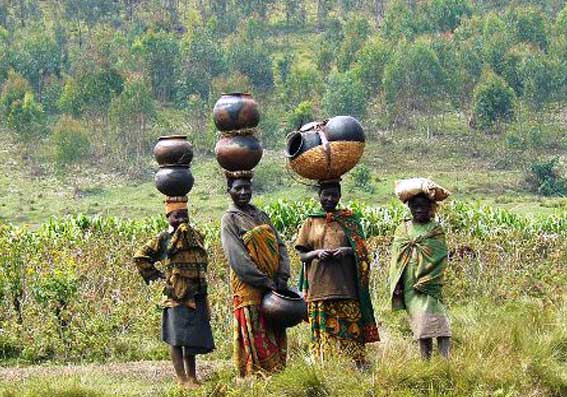
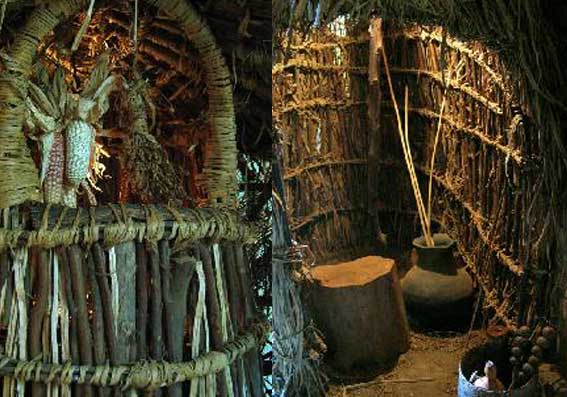
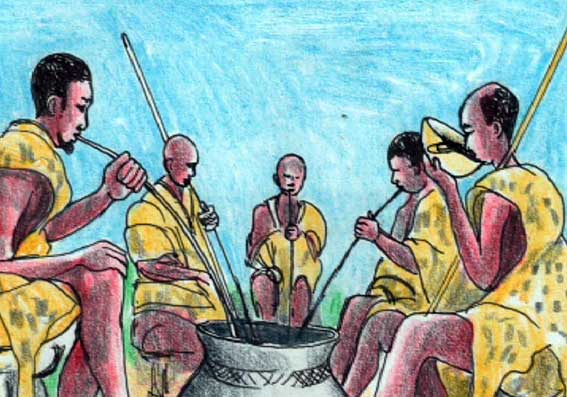
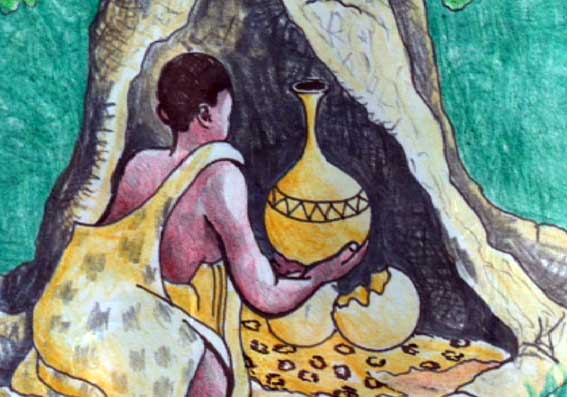
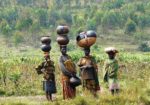
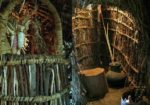

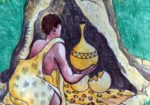
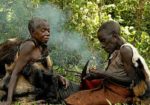

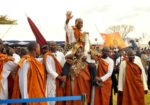

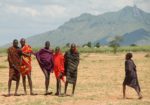








4 Comment
Nkurunungi Rogers, 2022-11-27 at 12:53 PM
I’m glad to get this information. Very wonderful
Priscilla Tibikimpenda, 2022-05-15 at 4:52 PM
I’m a person who is always wants to know more about my tribe but in all I have read I didn’t meet my clan .Yet my grandfather was greatest man known as a great fighter .
We would like to read about such people thanks
christmas emmanuel, 2021-08-13 at 10:06 PM
Nice to hear where i came from
Thanks very much and keep it up
Visit the historical Kisiizi Falls and Monument in Rukungiri district, 2018-09-19 at 12:57 PM
[…] Kisiizi falls was a tragic place where unmarried pregnant Bakiga girls were punished to death. This practice was discontinued and what had been a place of despair […]